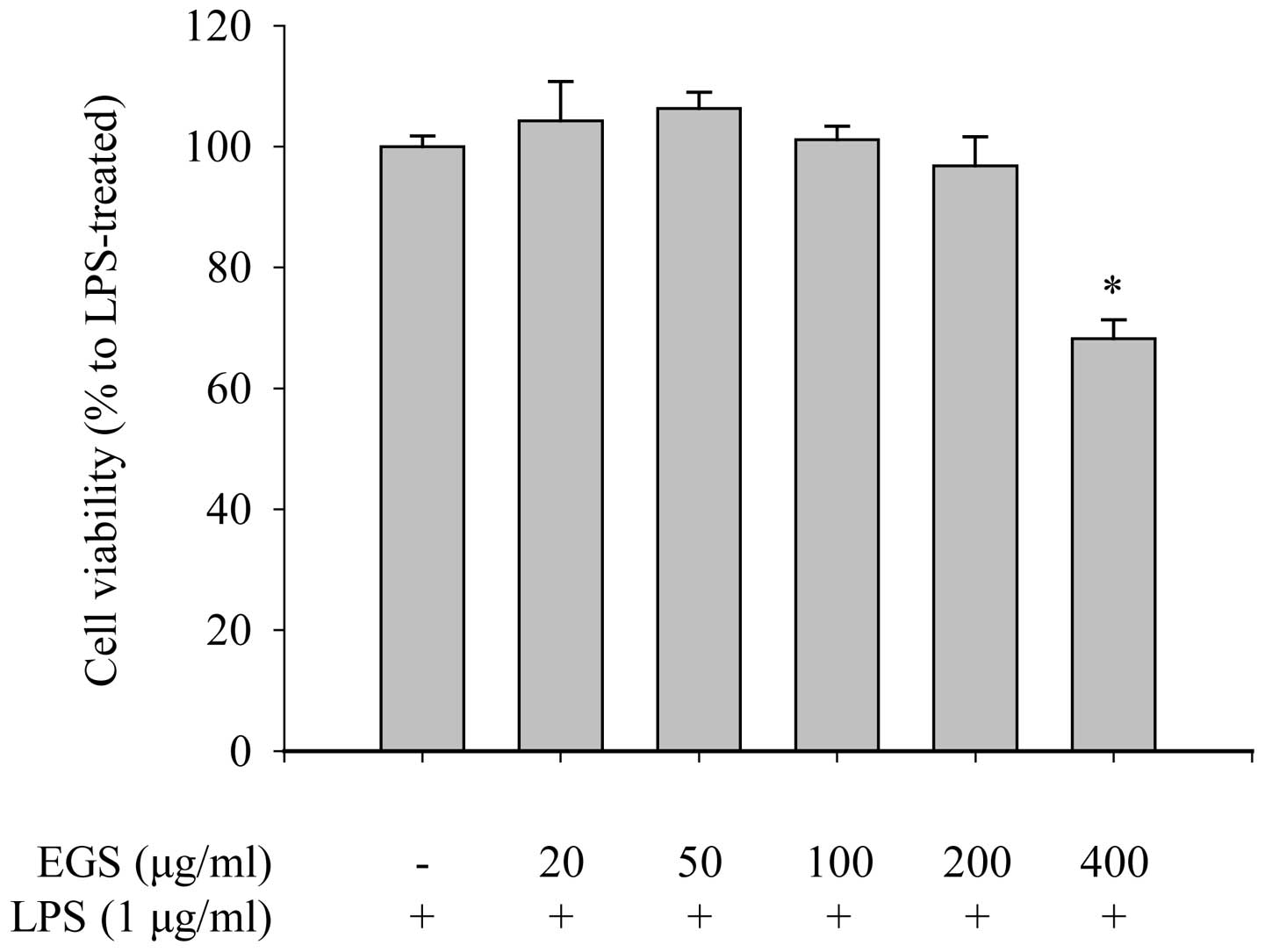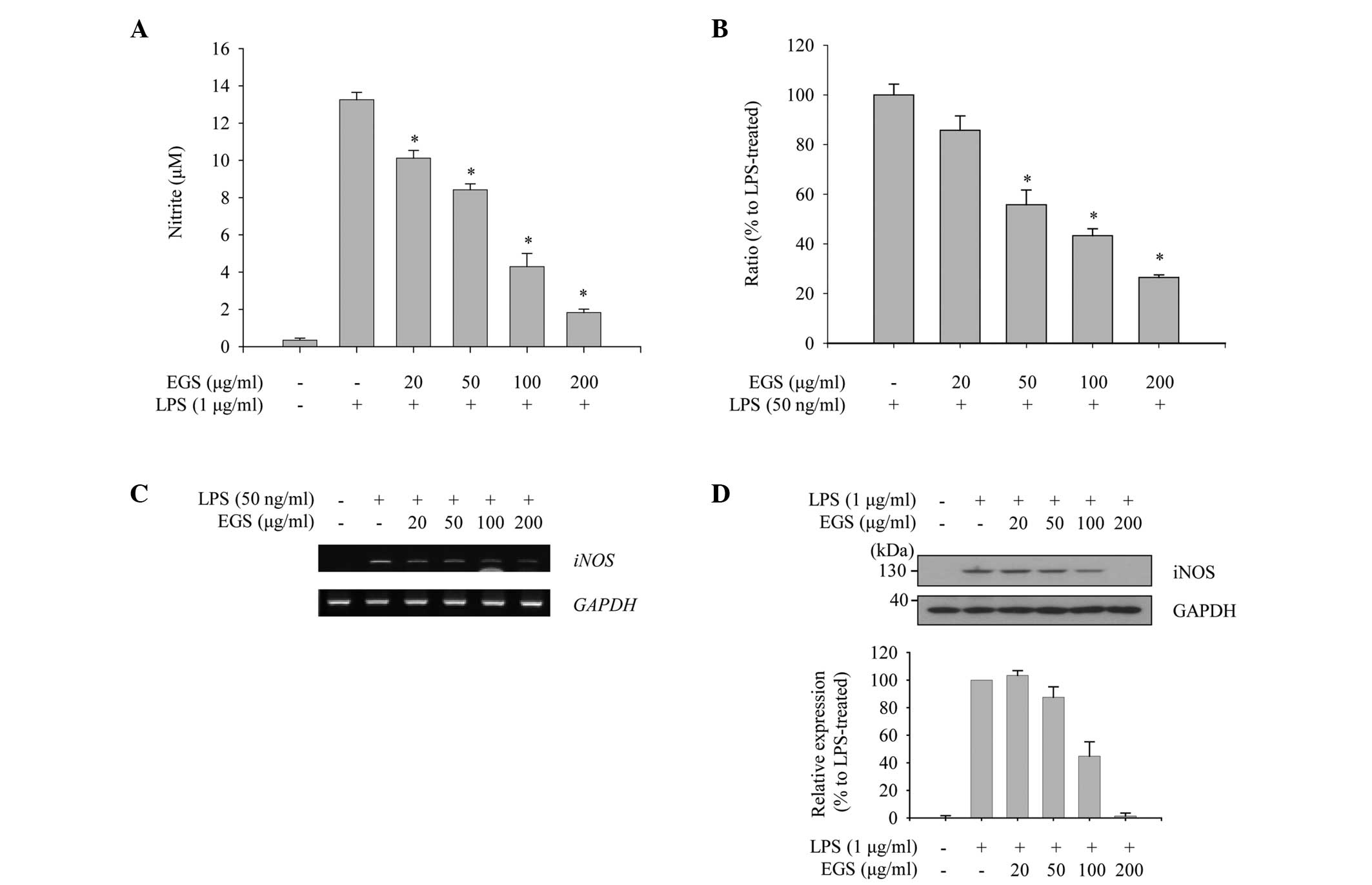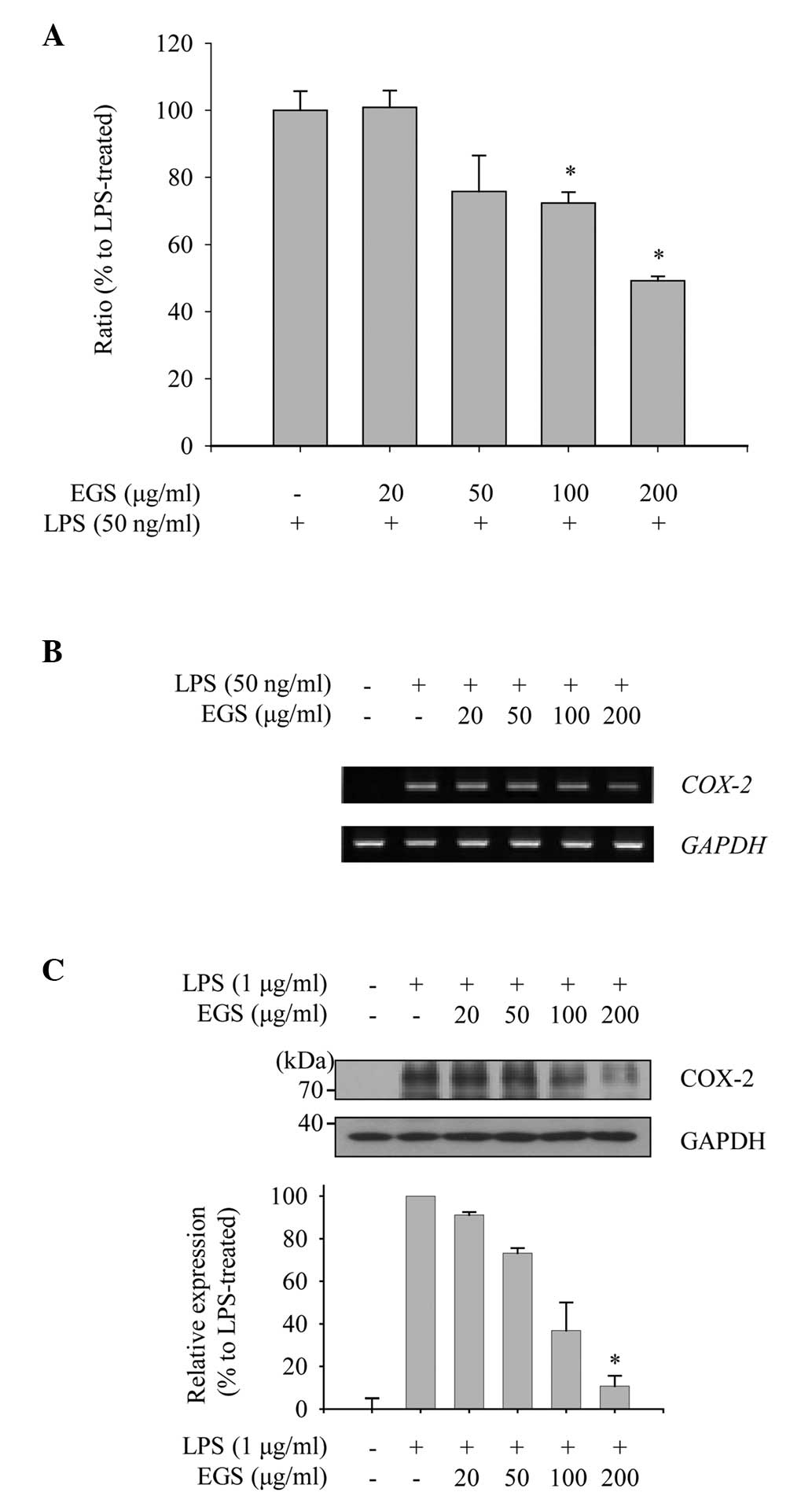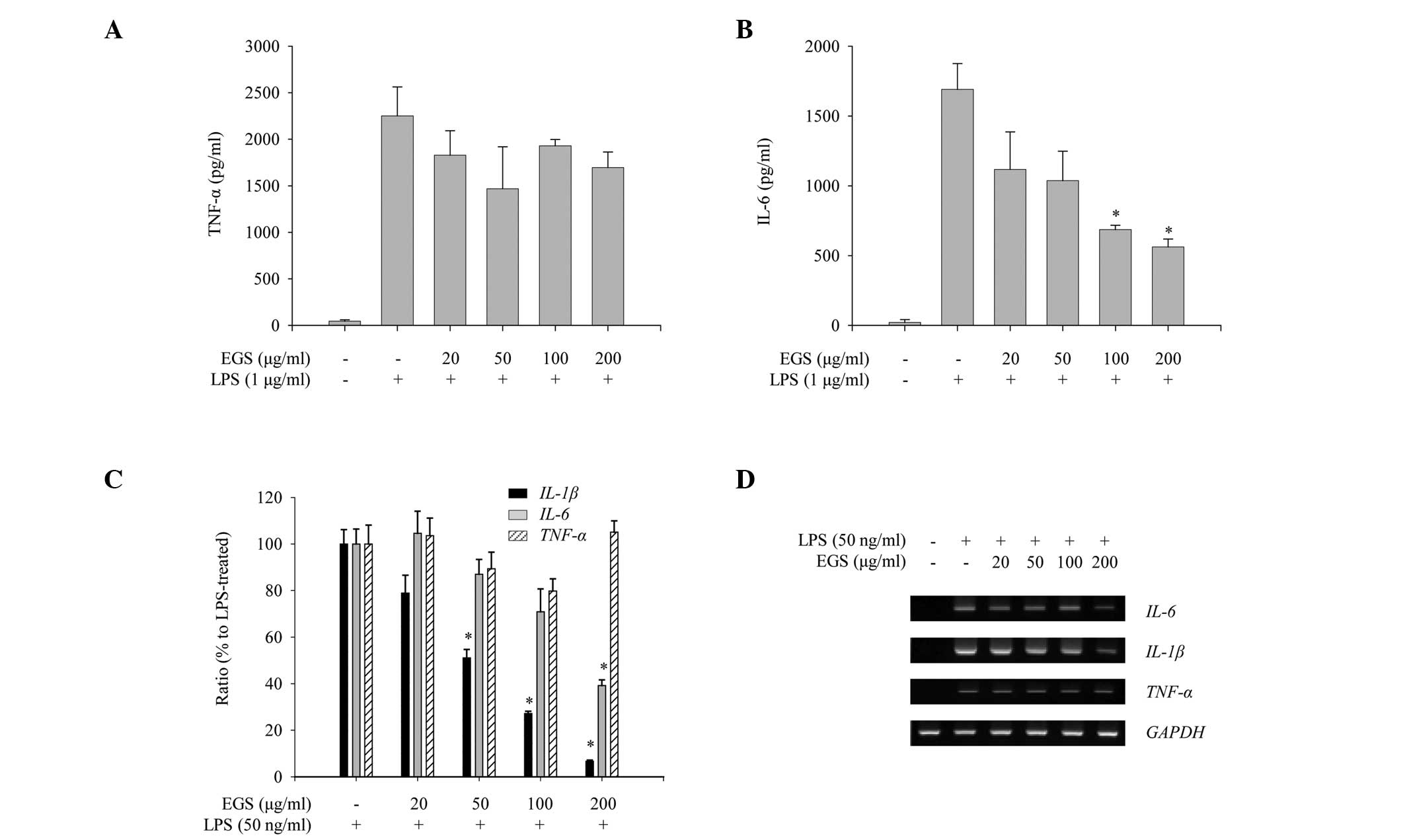|
1
|
Boscá L, Zeini M, Través PG and Hortelano
S: Nitric oxide and cell viability in inflammatory cells: A role
for NO in macrophage function and fate. Toxicology. 208:249–258.
2005. View Article : Google Scholar : PubMed/NCBI
|
|
2
|
Fujihara M, Muroi M, Tanamoto K, Suzuki T,
Azuma H and Ikeda H: Molecular mechanisms of macrophage activation
and deactivation by lipopolysaccharide: Roles of the receptor
complex. Pharmacol Ther. 100:171–194. 2003. View Article : Google Scholar : PubMed/NCBI
|
|
3
|
Fujiwara N and Kobayashi K: Macrophages in
inflammation. Curr Drug Targets Inflamm Allergy. 4:281–286. 2005.
View Article : Google Scholar : PubMed/NCBI
|
|
4
|
MacMicking J, Xie QW and Nathan C: Nitric
oxide and macrophage function. Annu Rev Immunol. 15:323–350. 1997.
View Article : Google Scholar : PubMed/NCBI
|
|
5
|
Jones BW, Heldwein KA, Means TK, Saukkonen
JJ and Fenton MJ: Differential roles of toll-like receptors in the
elicitation of proinflammatory responses by macrophages. Ann Rheum
Dis. 60(Suppl 3): iii6–iii12. 2001.
|
|
6
|
Jones BW, Means TK, Heldwein KA, Keen MA,
Hill PJ, Belisle JT and Fenton MJ: Different toll-like receptor
agonists induce distinct macrophage responses. J Leukoc Biol.
69:1036–1044. 2001.PubMed/NCBI
|
|
7
|
Rhee SH and Hwang D: Murine TOLL-like
receptor 4 confers lipopolysaccharide responsiveness as determined
by activation of NF kappa B and expression of the inducible
cyclooxygenase. J Biol Chem. 275:34035–34040. 2000. View Article : Google Scholar : PubMed/NCBI
|
|
8
|
Schroder K, Sweet MJ and Hume DA: Signal
integration between IFNgamma and TLR signalling pathways in
macrophages. Immunobiology. 211:511–524. 2006. View Article : Google Scholar : PubMed/NCBI
|
|
9
|
Stalińska K, Guzdek A, Rokicki M and Koj
A: Transcription factors as targets of the anti-inflammatory
treatment. A cell culture study with extracts from some
mediterranean diet plants. J Physiol Pharmacol. 56(Suppl 1):
S157–S169. 2005.
|
|
10
|
Szabó C and Thiemermann C: Regulation of
the expression of the inducible isoform of nitric oxide synthase.
Adv Pharmacol. 34:113–153. 1995. View Article : Google Scholar : PubMed/NCBI
|
|
11
|
Clancy RM, Amin AR and Abramson SB: The
role of nitric oxide in inflammation and immunity. Arthritis
Rheumatol. 41:1141–1151. 1998. View Article : Google Scholar
|
|
12
|
Guadagni F, Ferroni P, Palmirotta R,
Portarena I, Formica V and Roselli M: Review. TNF/VEGF cross-talk
in chronic inflammation-related cancer initiation and progression:
An early target in anticancer therapeutic strategy. In Vivo.
21:147–161. 2007.PubMed/NCBI
|
|
13
|
Kröncke KD, Fehsel K and Kolb-Bachofen V:
Inducible nitric oxide synthase in human diseases. Clin Exp
Immunol. 113:147–156. 1998. View Article : Google Scholar : PubMed/NCBI
|
|
14
|
Nathan C and Xie QW: Nitric oxide
synthases: Roles, tolls and controls. Cell. 78:915–918. 1994.
View Article : Google Scholar : PubMed/NCBI
|
|
15
|
Nathan C and Xie QW: Regulation of
biosynthesis of nitric oxide. J Biol Chem. 269:13725–13728.
1994.PubMed/NCBI
|
|
16
|
Nishimoto N and Kishimoto T: Interleukin
6: From bench to bedside. Nat Clin Pract Rheumatol. 2:619–626.
2006. View Article : Google Scholar : PubMed/NCBI
|
|
17
|
Calixto JB: Efficacy, safety, quality
control, marketing and regulatory guidelines for herbal medicines
(phytotherapeutic agents). Braz J Med Biol Res. 33:179–189. 2000.
View Article : Google Scholar : PubMed/NCBI
|
|
18
|
Wutthithamavet W: Thai traditional
medicine. revised edition. Odean Store Press; Bangkok: 1997
|
|
19
|
Tewtrakul S, Wattanapiromsakul C and
Mahabusarakam W: Effects of compounds from Garcinia mangostana on
inflammatory mediators in RAW264.7 macrophage cells. J
Ethnopharmacol. 121:379–382. 2009. View Article : Google Scholar
|
|
20
|
Cui J, Hu W, Cai Z, Liu Y, Li S, Tao W and
Xiang H: New medicinal properties of mangostins: Analgesic activity
and pharmacological characterization of active ingredients from the
fruit hull of Garcinia mangostana L. Pharmacol Biochem Behav.
95:166–172. 2010. View Article : Google Scholar : PubMed/NCBI
|
|
21
|
Duke JA: Handbook of medical herbs.
Library of congress; New York: 1985
|
|
22
|
Evan WC: Trease and Evans pharmacognosy.
Saunders Company Limited; Nottingham: 1996
|
|
23
|
Panthong A, Norkaew P, Kanjanapothi D,
Taesotikul T, Anantachoke N and Reutrakul V: Anti-inflammatory,
analgesic and antipyretic activities of the extract of gamboge from
Garcinia hanburyi Hook f. J Ethnopharmacol. 111:335–340. 2007.
View Article : Google Scholar : PubMed/NCBI
|
|
24
|
Guimarães CL, Otuki MF, Beirith A and
Cabrini DA: A review on the therapeutic potential of Garcinia
gardneriana. Dynamis. 12:6–12. 2004.In Portuguese.
|
|
25
|
Castardo JC, Prudente AS, Ferreira J,
Guimarães CL, Monache FD, Filho VC, Otuki MF and Cabrini DA:
Anti-inflammatory effects of hydroalcoholic extract and two
biflavonoids from Garcinia gardneriana leaves in mouse paw oedema.
J Ethnopharmacol. 118:405–411. 2008. View Article : Google Scholar : PubMed/NCBI
|
|
26
|
Ayepola OR, Chegou NN, Brooks NL and
Oguntibeju OO: Kolaviron, a Garcinia biflavonoid complex
ameliorates hyperglycemia-mediated hepatic injury in rats via
suppression of inflammatory responses. BMC Complement Altern Med.
13:3632013. View Article : Google Scholar : PubMed/NCBI
|
|
27
|
Farombi EO, Adedara IA, Ajayi BO, Ayepola
OR and Egbeme EE: Kolaviron, a natural antioxidant and
anti-inflammatory phyto-chemical prevents dextran sulphate
sodium-induced colitis in rats. Basic Clin Pharmacol Toxicol.
113:49–55. 2013. View Article : Google Scholar : PubMed/NCBI
|
|
28
|
Li F, Shanmugam MK, Chen L, Chatterjee S,
Basha J, Kumar AP, Kundu TK and Sethi G: Garcinol, a
polyisoprenylated benzophenone modulates multiple proinflammatory
signaling cascades leading to the suppression of growth and
survival of head and neck carcinoma. Cancer Prev Res (Phila).
6:843–854. 2013. View Article : Google Scholar
|
|
29
|
Tsai ML, Chiou YS, Chiou LY, Ho CT and Pan
MH: Garcinol suppresses inflammation-associated colon
carcinogenesis in mice. Mol Nutr Food Res. 58:1820–1829. 2014.
View Article : Google Scholar : PubMed/NCBI
|
|
30
|
Minami H, Takahashi E, Fukuyama Y, Kodama
M, Yoshizawa T and Nakagawa K: Novel xanthones with superoxide
scavenging activity from Garcinia subelliptica. Chem Pharm Bull
(Tokyo). 43:347–349. 1995. View Article : Google Scholar
|
|
31
|
Minami H, Hamaguchi K, Kubo M and Fukuyama
Y: A benzophenone and a xanthone from Garcinia subelliptica.
Phytochemistry. 49:1783–1785. 1998. View Article : Google Scholar
|
|
32
|
Ito T, Yokota R, Watarai T, Mori K, Oyama
M, Nagasawa H, Matsuda H and Iinuma M: Isolation of six
isoprenylated biflavonoids from the leaves of Garcinia
subelliptica. Chem Pharm Bull (Tokyo). 61:551–558. 2013. View Article : Google Scholar
|
|
33
|
Weng JR, Tsao LT, Wang JP, Wu RR and Lin
CN: Anti-inflammatory phloroglucinols and terpenoids from Garcinia
subelliptica. J Nat Prod. 67:1796–1799. 2004. View Article : Google Scholar : PubMed/NCBI
|
|
34
|
Weng JR, Lin CN, Tsao LT and Wang JP:
Terpenoids with a new skeleton and novel triterpenoids with
anti-inflammatory effects from Garcinia subelliptica. Chemistry.
9:5520–5527. 2003. View Article : Google Scholar : PubMed/NCBI
|
|
35
|
Weng JR, Lin CN, Tsao LT and Wang JP:
Novel and anti-inflammatory constituents of Garcinia subelliptica.
Chemistry. 9:1958–1963. 2003. View Article : Google Scholar : PubMed/NCBI
|
|
36
|
Livak KJ and Schmittgen TD: Analysis of
relative gene expression data using real-time quantitative PCR and
the 2−ΔΔCt method. Methods. 25:402–408. 2001. View Article : Google Scholar
|
|
37
|
Koressaar T and Remm M: Enhancements and
modifications of primer design program Primer3. Bioinformatics.
23:1289–91. 2007. View Article : Google Scholar : PubMed/NCBI
|
|
38
|
Samavati L, Rastogi R, Du W, Hüttemann M,
Fite A and Franchi L: STAT3 tyrosine phosphorylation is critical
for interleukin 1 beta and interleukin-6 production in response to
lipopolysaccharide and live bacteria. Mol Immunol. 46:1867–1877.
2009. View Article : Google Scholar : PubMed/NCBI
|
|
39
|
Zhu ZG, Jin H, Yu PJ, Tian YX, Zhang JJ
and Wu SG: Mollugin Inhibits the inflammatory response in
lipopolysaccharide-stimulated RAW264.7 macrophages by blocking the
Janus kinase-signal transducers and activators of transcription
signaling pathway. Biol Pharm Bull. 36:399–406. 2013. View Article : Google Scholar : PubMed/NCBI
|
|
40
|
Lee C, Lim HK, Sakong J, Lee YS, Kim JR
and Baek SH: Janus kinase-signal transducer and activator of
transcription mediates phosphatidic acid-induced interleukin
(IL)-1beta and IL-6 production. Mol Pharmacol. 69:1041–1047.
2006.
|
|
41
|
Cario E, Rosenberg IM, Brandwein SL, Beck
PL, Reinecker HC and Podolsky DK: Lipopolysaccharide activates
distinct signaling pathways in intestinal epithelial cell lines
expressing toll-like receptors. J Immunol. 164:966–972. 2000.
View Article : Google Scholar : PubMed/NCBI
|
|
42
|
Burk DR, Senechal-Willis P, Lopez LC,
Hogue BG and Daskalova SM: Suppression of
lipopolysaccharide-induced inflammatory responses in RAW 264.7
murine macrophages by aqueous extract of Clinopodium vulgare L.
(Lamiaceae). J Ethnopharmacol. 126:397–405. 2009. View Article : Google Scholar : PubMed/NCBI
|
|
43
|
Liu H, Bargouti M, Zughaier S, Zheng Z,
Liu Y, Sangadala S, Boden SD and Titus L: Osteoinductive LIM
mineralization protein-1 suppresses activation of NF-kappaB and
selectively regulates MAPK pathways in pre-osteoclasts. Bone.
46:1328–1335. 2010. View Article : Google Scholar :
|
|
44
|
Shan J, Fu J, Zhao Z, Kong X, Huang H, Luo
L and Yin Z: Chlorogenic acid inhibits lipopolysaccharide-induced
cyclo-oxygenase-2 expression in RAW264.7 cells through suppressing
NF-kappaB and JNK/AP-1 activation. Int Immunopharmacol.
9:1042–1048. 2009. View Article : Google Scholar : PubMed/NCBI
|
|
45
|
Watters JJ, Sommer JA, Pfeiffer ZA, Prabhu
U, Guerra AN and Bertics PJ: A differential role for the
mitogen-activated protein kinases in lipopolysaccharide signaling:
The MEK/ERK pathway is not essential for nitric oxide and
interleukin 1beta production. J Biol Chem. 277:9077–9087. 2002.
View Article : Google Scholar : PubMed/NCBI
|
|
46
|
Caivano M: Role of MAP kinase cascades in
inducing arginine transporters and nitric oxide synthetase in
RAW264 macrophages. FEBS Lett. 429:249–253. 1998. View Article : Google Scholar : PubMed/NCBI
|
|
47
|
Paul A, Cuenda A, Bryant CE, Murray J,
Chilvers ER, Cohen P, Gould GW and Plevin R: Involvement of
mitogen-activated protein kinase homologues in the regulation of
lipopolysaccharide-mediated induction of cyclo-oxygenase-2 but not
nitric oxide synthase in RAW 264.7 macrophages. Cell Signal.
11:491–497. 1999. View Article : Google Scholar : PubMed/NCBI
|














